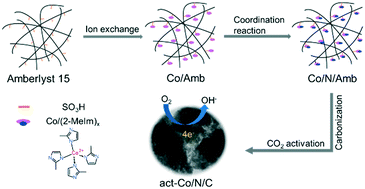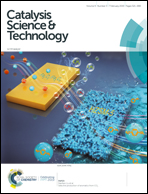Anchoring a Co/2-methylimidazole complex on ion-exchange resin and its transformation to Co/N-doped carbon as an electrocatalyst for the ORR†
Abstract
Synthesizing high-activity metal/heteroatom-co-doped carbon (M/H–C) electrocatalysts for the oxygen reduction reaction (ORR) is critical for the commercialization of fuel cells, but remains challenging because of the difficulty in making highly dispersed (M/H–C) electrocatalysts. Herein, a commercial ion-exchange resin, Amberlyst 15, is used as a support, and Co/2-methylimidazole is anchored on the ion-exchange site of the support to obtain Co/N/Amb as the precursor of the M/H–C electrocatalyst. After the precursor is pyrolyzed and converted into Co/N/C materials, it is activated with CO2, and the obtained material (act-Co/N/C) exhibits remarkable ORR activity with a high onset potential of 0.943 V (vs. the reversible hydrogen electrode) and an excellent kinetic current density comparable to commercial 5 wt% Pt/C in an alkaline medium. The favorable activity is mainly attributed to the ultra-dispersed CoNx and high porosity of act-Co/N/C. Our synthetic strategy could be applied to the preparation of other well-dispersed M/H–C materials. This work opens a new direction in the synthetic strategy of carbon materials.



 Please wait while we load your content...
Please wait while we load your content...